Gion Matsuri is a cornerstone of Kyoto's cultural identity, deeply rooted in its history and traditions. Dating back to the 9th century, this Japanese festival originally emerged as a response to challenges like epidemics and natural disasters, evolving over time into a vibrant celebration of community and heritage.
Held annually throughout July, it draws visitors worldwide to experience Kyoto's rich cultural tapestry through grand parades, intricate floats, and spirited festivities. Gion Matsuri not only honors ancient rituals but also serves as a testament to the enduring spirit of Japan's cultural heritage.

Brief History Of Gion Matsuri
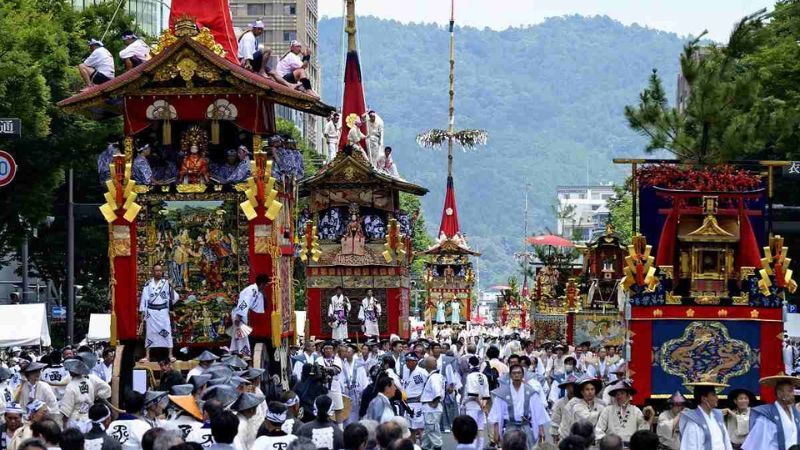
Gion Matsuri traces its origins back to the 9th century, during the Heian Period (794-1185). It was initially established as a religious ceremony to appease the gods during outbreaks of plague and other calamities that frequently afflicted Kyoto. The Yasaka Shrine, dedicated to the deity Susanoo-no-Mikoto (god of storms and plagues), became central to the festival's rituals and celebrations. Over time, the festival evolved beyond its religious origins to become a symbol of community solidarity and cultural pride in Kyoto.
Throughout its long history, Gion Matsuri has weathered numerous changes and adaptations. During the 16th century, the festival was temporarily suspended due to civil unrest and war. However, it was revived in the 17th century and transformed into the grand event we recognize today. The highlight of the festival, the Yamaboko Junko procession of elaborately decorated floats (yamaboko), was established during this period and has continued to be a focal point of Gion Matsuri ever since. The festival has also adapted to incorporate new elements and maintain its relevance in modern times, while still honoring its ancient roots and traditions.

When Does Gion Matsuri Take Place?
Gion Matsuri is held annually throughout the month of July in Kyoto, Japan. The festival reaches its peak around July 17th, known as "Gion Matsuri Saki Matsuri" (first parade), which features the Yamaboko Junko procession. The festivities span the entire month with various events and rituals leading up to and following this main parade.
The detailed schedule of main events during Gion Matsuri:
Mikoshi Arai: On July 10th, portable shrines (mikoshi) from Yasaka Shrine are purified with water from the Kamo River, marking the start of the festival.
Yoiyama: From July 14th to 16th, the city comes alive with Yoiyama evenings, where streets in the Gion district and around Yasaka Shrine are lined with traditional lanterns and food stalls. This period allows visitors to enjoy the festive atmosphere and view the yamaboko floats up close.
Yamaboko Junko: The highlight occurs on July 17th, with the Yamaboko Junko parade. Massive wooden floats adorned with intricate tapestries and artifacts are pulled through the streets of Kyoto by groups of men clad in traditional attire. This procession showcases the craftsmanship and artistry of Kyoto's artisans and is accompanied by traditional music and performances.
Ato Matsuri: On July 24th, the festival concludes with the Ato Matsuri (latter parade), where the floats return to their starting points, marking the end of Gion Matsuri for another year.
What Are Gion Matsuri Events?
Apart from the iconic Yamaboko Junko parade, Gion Matsuri offers a variety of events that enrich the cultural tapestry of Kyoto:
Yoiyama and Yoiyoiyama Evenings: Leading up to the main parade on July 17th, Kyoto's streets transform into lively festival grounds during Yoiyama (July 14th to 16th) and Yoiyoiyama (July 13th). These evenings are characterized by lantern-lit streets in the Gion and Yasaka Shrine areas, where locals and visitors can enjoy strolling among food stalls (yatai) offering traditional snacks and beverages. It's an excellent opportunity to experience Kyoto's festive atmosphere and witness the illuminated yamaboko floats up close.
Mikoshi Processions: On July 10th, portable shrines (mikoshi) from Yasaka Shrine are paraded through the city streets. This ritual symbolizes the cleansing and purification of the shrines, bringing blessings to the community and participants.
Kagura Dance: At Yasaka Shrine and various venues across Kyoto, traditional Kagura dances are performed to entertain and invoke the gods' blessings. These sacred dances are accompanied by traditional music, often featuring drums, flutes, and other instruments.
Bugaku Performances: Bugaku refers to ancient court music and dance performed during Gion Matsuri at specific venues in Kyoto. These performances highlight the refined elegance of traditional Japanese court culture and are a testament to the festival's historical roots.
Ritual Offerings and Ceremonies: Throughout the festival, various rituals are conducted at Yasaka Shrine and other important shrines in Kyoto to honor the deities and seek blessings for prosperity and good fortune. These rituals often include prayers, offerings of food and sake, and traditional chants performed by Shinto priests.
Folk Entertainment: In addition to formal performances, Gion Matsuri also features lively street entertainment, including folk music (min'yo) performances, puppet shows (kugutsu), and other forms of traditional entertainment that add to the festive ambiance.
Read Also:


Yamaboko Junko Parade

During Gion Matsuri, specifically on July 17th, Kyoto's streets come alive with the Yamaboko Junko parade. The parade features towering yamaboko and elaborate floats that are meticulously crafted and adorned with ancient tapestries, textiles, and treasures. These floats are pulled through the city by teams of men in traditional attire, showcasing both strength and precision as they navigate Kyoto's narrow streets.
Highlight key floats and their significance:
- Naginata Boko: Known for its towering height and impressive decorative elements, the Naginata Boko float prominently displays a ceremonial halberd (naginata) atop its structure. This float symbolizes the strength and valor of ancient warriors.
- Kanko Boko: This float is distinguished by its unique design and ornate carvings, reflecting intricate craftsmanship and historical narratives. It often features intricate tapestries and carvings that depict scenes from mythology or historical events.
- Fune Boko: The Fune Boko float resembles a majestic ship, adorned with maritime motifs and symbols. It represents Japan's seafaring heritage and is a tribute to the country's maritime culture.
What To Do During Gion Matsuri?
During Gion Matsuri, the streets of Kyoto come alive with a myriad of attractions and stalls offering a taste of local culture and culinary delights:
Food Stalls (Yatai)
Yatai line the streets during Yoiyama and Yoiyoiyama evenings, offering a variety of traditional Japanese snacks and street foods. Popular choices include yakitori (grilled chicken skewers), takoyaki (octopus balls), okonomiyaki (savory pancakes), and taiyaki (fish-shaped pastries filled with sweet fillings).
Traditional Craft Stalls
Throughout the festival, stalls selling traditional crafts such as Kyoto ceramics, textiles, fans (uchiwa), and wooden crafts are set up. Visitors can admire and purchase these handmade items, often crafted using centuries-old techniques unique to Kyoto.
Games and Amusements
Festive games and amusements, such as goldfish scooping (kingyo-sukui), yo-yo balloons (senko-hanabi), and ring toss (wanage), provide entertainment for both children and adults alike.
Kyoto Cuisine
Gion Matsuri is an excellent opportunity to indulge in Kyoto's renowned cuisine. Local specialties include kaiseki ryori (traditional multi-course meals), obanzai (home-style Kyoto dishes), and matcha (green tea) sweets like wagashi (traditional Japanese confections).
Traditional Crafts
Visitors can explore and purchase a wide range of traditional crafts unique to Kyoto, such as:
- Kyo-Yuzen: Hand-dyed textiles with intricate patterns and designs.
- Kyo-Kanoko Shibori: Tie-dyed fabrics known for their delicate and sophisticated patterns.
- Kyoto Ceramics: Pottery and porcelain featuring elegant designs and glazes, including Kiyomizu-yaki and Kyo-yaki.
- Festival Souvenirs: Various souvenirs and commemorative items related to Gion Matsuri, such as miniature yamaboko floats, festival-themed apparel, and accessories adorned with motifs from the festival, are available for purchase.
How Does The Gion Festival Reflects Kyoto's Cultural Heritage?
Gion Matsuri is a poignant reflection of Kyoto's rich cultural heritage and historical legacy:
Traditional Arts and Crafts
The festival showcases Kyoto's mastery of traditional arts and crafts, from the intricate designs of yamaboko floats to the delicate patterns of Kyo-Yuzen textiles and Kyo-Kanoko Shibori. These artistic expressions highlight Kyoto's role as a cultural hub where craftsmanship and aesthetics are meticulously preserved and passed down through generations.
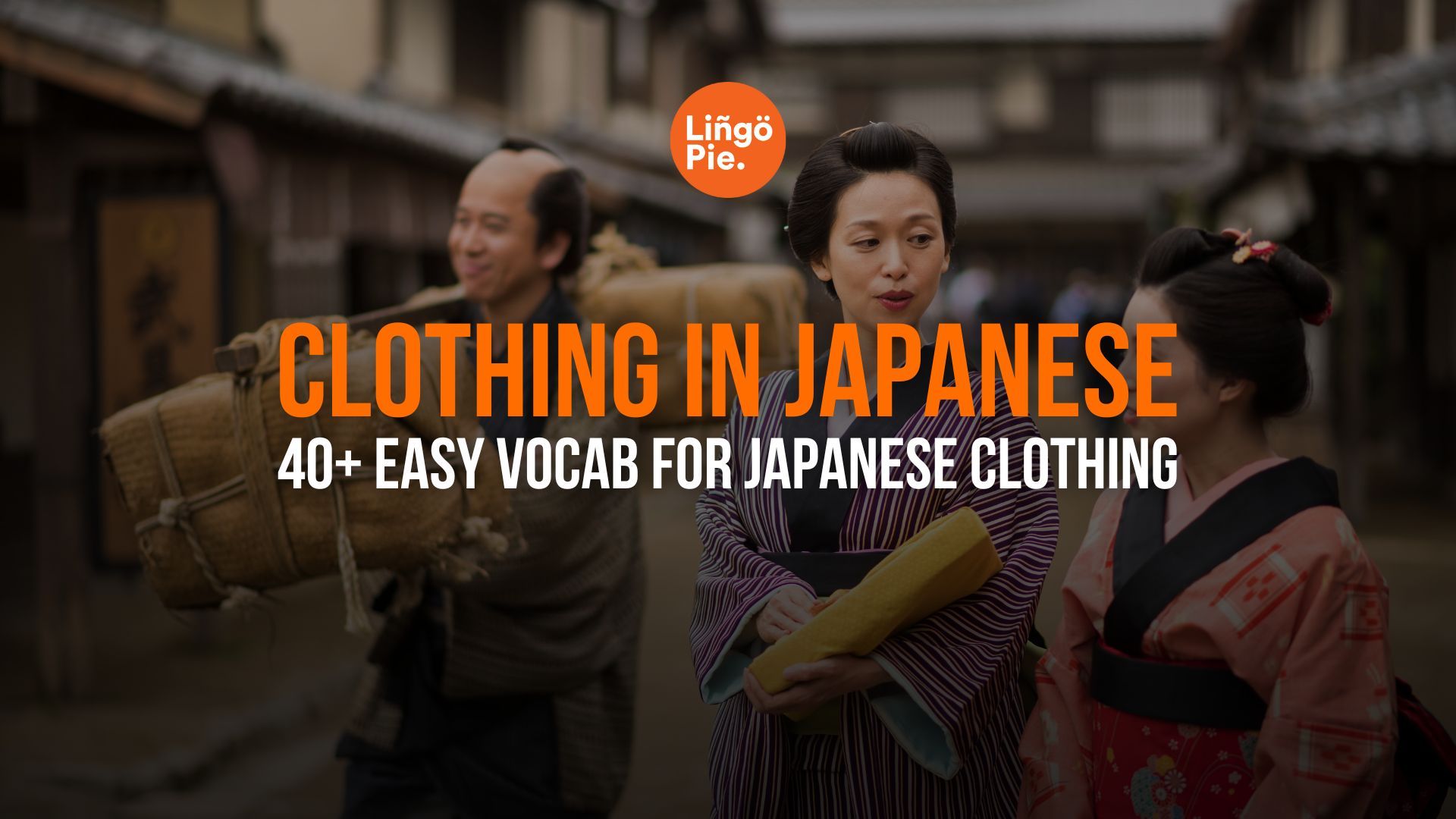
Historical Narratives
Each yamaboko float in the Yamaboko Junko parade is not only a visual spectacle but also a testament to Kyoto's historical narratives. The themes depicted on the floats often reference myths, legends, and significant events from Japanese history, offering spectators a glimpse into the city's storied past and cultural identity.
Shinto Rituals
Originating as a purification ritual to appease the gods and ward off calamities, Gion Matsuri continues to incorporate important Shinto rituals and ceremonies. These rituals, conducted at Yasaka Shrine and other sacred sites, involve prayers, offerings, and performances to honor the deities and seek their blessings for the community's prosperity and well-being.
Preservation of Traditions
Gion Matsuri plays a vital role in preserving and promoting Kyoto's intangible cultural heritage. Through rituals, performances, and craftsmanship associated with the festival, Kyoto reaffirms its commitment to safeguarding traditions that define its unique cultural identity, ensuring they endure for future generations.
Tips For Visitors
Best Times to Visit: Mid-July hosts the main events of Gion Matsuri, such as the Yamaboko Junko parade. July 14th to 16th is perfect for experiencing the festive atmosphere and seeing the floats up close. Avoid the largest crowds by arriving early morning or late afternoon.
Transportation: Expect crowded public transport (buses, trains) during Gion Matsuri. Consider biking or walking within the city center for easier access to festival sites. Taxis and ride-sharing might face delays due to increased traffic.
Respect Cultural Norms: Gion Matsuri is steeped in cultural and religious traditions. Respect local customs like removing shoes before entering sacred areas and refraining from loud behavior.
Photography: While generally allowed, be mindful of where and when to take photos. Avoid flash photography, especially during rituals and performances. Respect designated areas.
Trash Disposal: Maintain cleanliness by using designated bins and recycling stations throughout the festival area. Dispose of trash responsibly.
Dress Code: No strict dress code, but wear comfortable attire and shoes suitable for walking and standing in hot, humid weather. Be prepared for variable weather conditions in July.
Interacting with Locals: Engage respectfully with locals and other festival-goers. Many residents actively participate in Gion Matsuri. Take the opportunity to learn from them about the festival's traditions and significance.
Read Also:
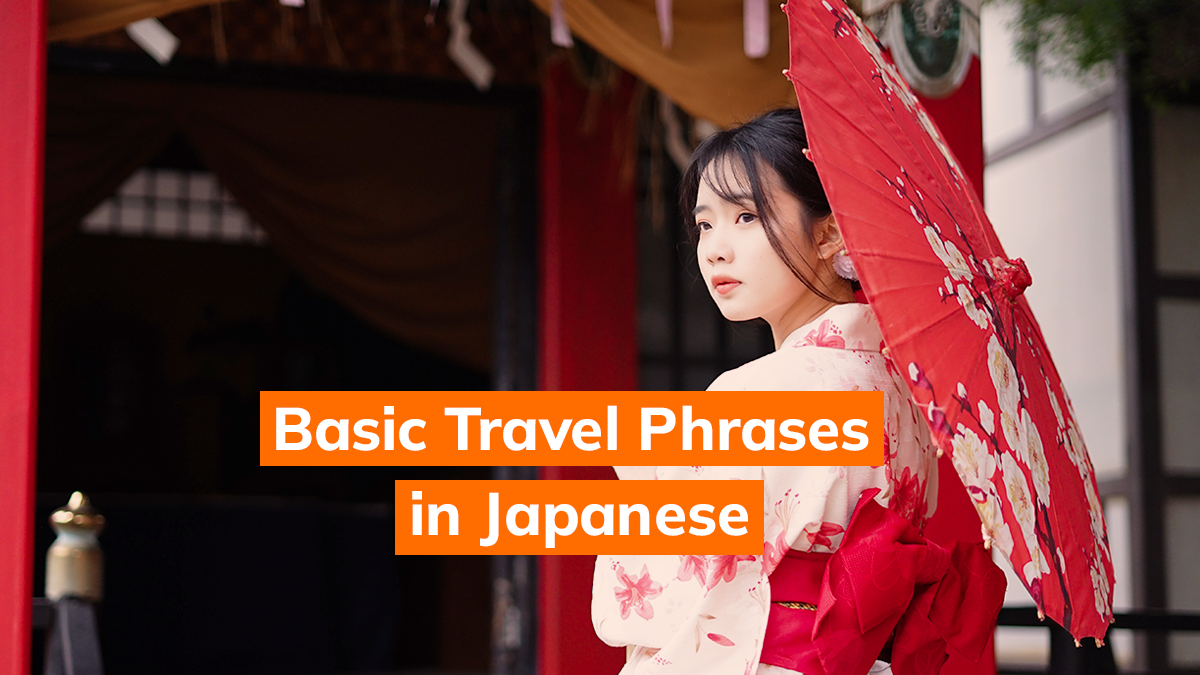
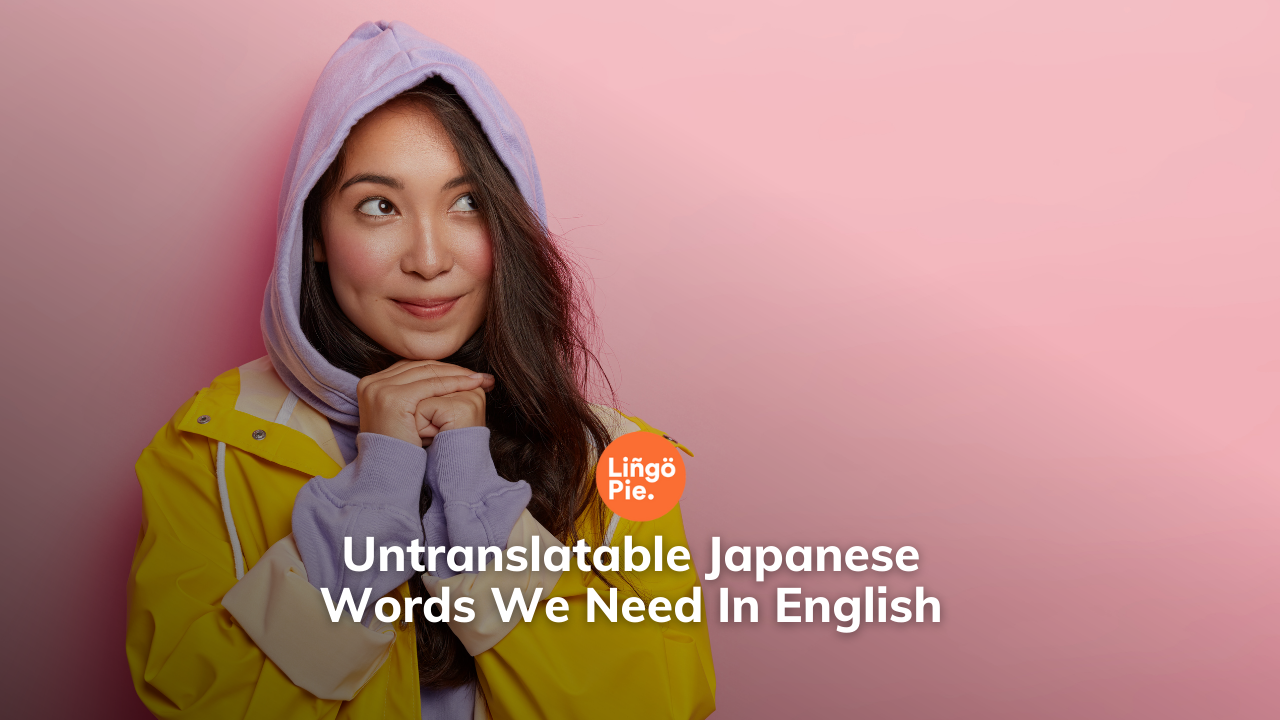
Useful Japanese Vocabulary For Gion Matsuri
- 祇園祭 (ぎおんまつり, Gion Matsuri) - Gion Festival
- 山鉾 (やまぼこ, Yamaboko) - Floats used in the parade
- 山鉾巡行 (やまぼこじゅんこう, Yamaboko Junko) - Procession of the floats
- 宵山 (よいやま, Yoiyama) - Festive evenings leading up to the parade
- 宵々山 (よいよいやま, Yoiyoiyama) - Eve of the Eve of the festival (July 13th)
- 後祭 (あとまつり, Ato Matsuri) - Latter festival (July 24th)
- 神輿 (みこし, Mikoshi) - Portable shrine
- 船鉾 (ふねぼこ, Funeboko) - Boat-shaped float
- 行列 (ぎょうれつ, Gyoretsu) - Procession or parade
- 屋台 (やたい, Yatai) - Food stalls
- 獅子舞 (ししぶ, Shishimai) - Lion dance
- 踊り (おどり, Odori) - Dance (referring to traditional performances)
- 太鼓 (たいこ, Taiko) - Japanese drums, often heard during the festival
- 浴衣 (ゆかた, Yukata) - Lightweight summer kimono worn by festival-goers
- 京都 (きょうと, Kyoto) - The city where Gion Festival takes place
Final Words
Gion Matsuri is a beautiful celebration deeply rooted in Kyoto's history and community spirit. From the stunning Yamaboko Junko parade to the lively Yoiyama evenings, this festival showcases centuries of tradition and craftsmanship. It's a time to honor Japan's spiritual heritage while enjoying the city's vibrant culture.
To truly appreciate Gion Matsuri, you have to experience it firsthand. Whether you're marveling at the ornate floats, tasting local foods, or chatting with friendly locals, this festival offers a unique window into Kyoto's soul.
For those eager to immerse themselves in the cultural richness of Japan even further, Lingopie offers an exceptional way to learn Japanese through real TV shows and music. Engage with the language as you watch authentic content, making your learning journey enjoyable and effective. Dive into the world of Lingopie today and enhance your appreciation of festivals like Gion Matsuri through language. Try Lingopie now and start your adventure in Japanese language learning!
Frequently Asked Questions
1. What is special about the Gion Matsuri?
Gion Matsuri is renowned for its ancient roots and dazzling floats, showcasing Kyoto's cultural heritage through traditional performances and vibrant street celebrations.
2. Is Gion Matsuri worth it?
Absolutely. It offers a unique glimpse into Kyoto's history and culture with grand parades, intricate floats, and delicious local foods, making it a memorable experience for visitors.
3. How long does Gion Matsuri last?
Gion Matsuri spans the entire month of July in Kyoto, with the main events, including the Yamaboko Junko parade, concentrated around mid-July, specifically July 17th.
4. What food is eaten during Gion Matsuri?
Festival-goers enjoy a variety of traditional Japanese foods at yatai (food stalls), such as yakitori, takoyaki, okonomiyaki, taiyaki, and other regional delicacies, adding to the festive ambiance of Gion and Yasaka Shrine areas.


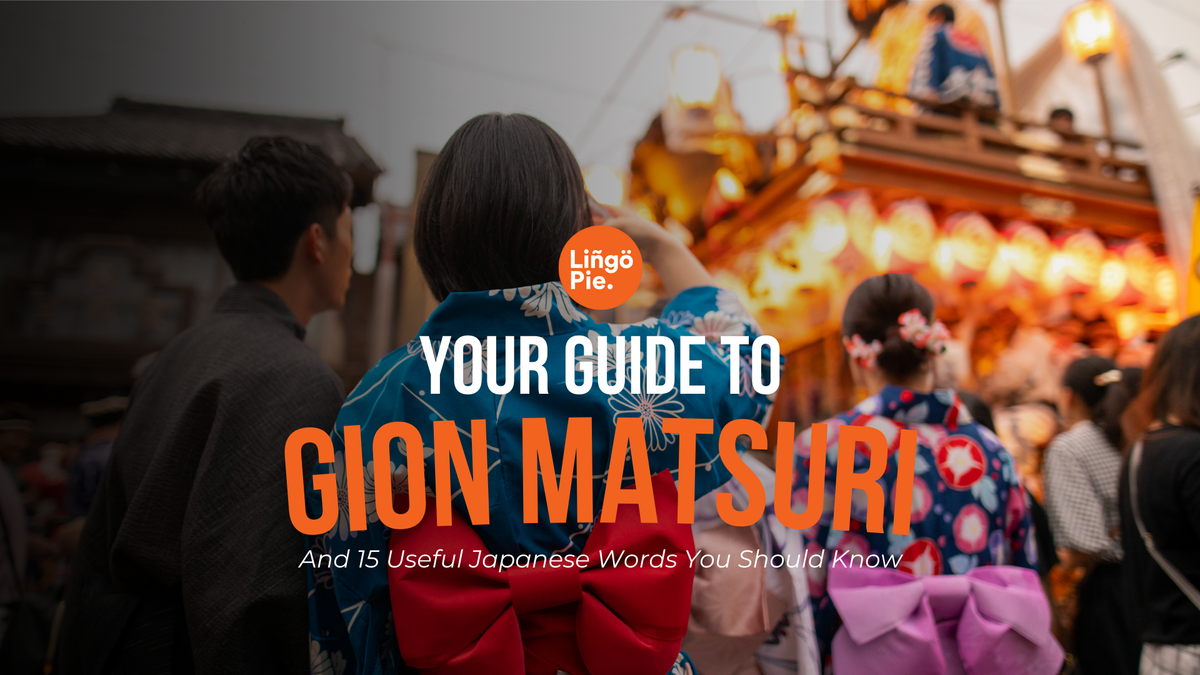




![6 Best Japanese Translation Apps For Learners [TESTED]](/blog/content/images/size/w300/2026/01/Best-Japanese-Translation-Apps.jpg)
![6 Best Japanese Language Apps Worth Trying [TESTED]](/blog/content/images/size/w300/2025/12/best-apps-to-Learn-Japanese.jpeg)
![A Guide To Kansai-ben Dialect For Beginners In Japanese [2026]](/blog/content/images/size/w300/2025/03/Kansai-ben-dialect.jpg)
